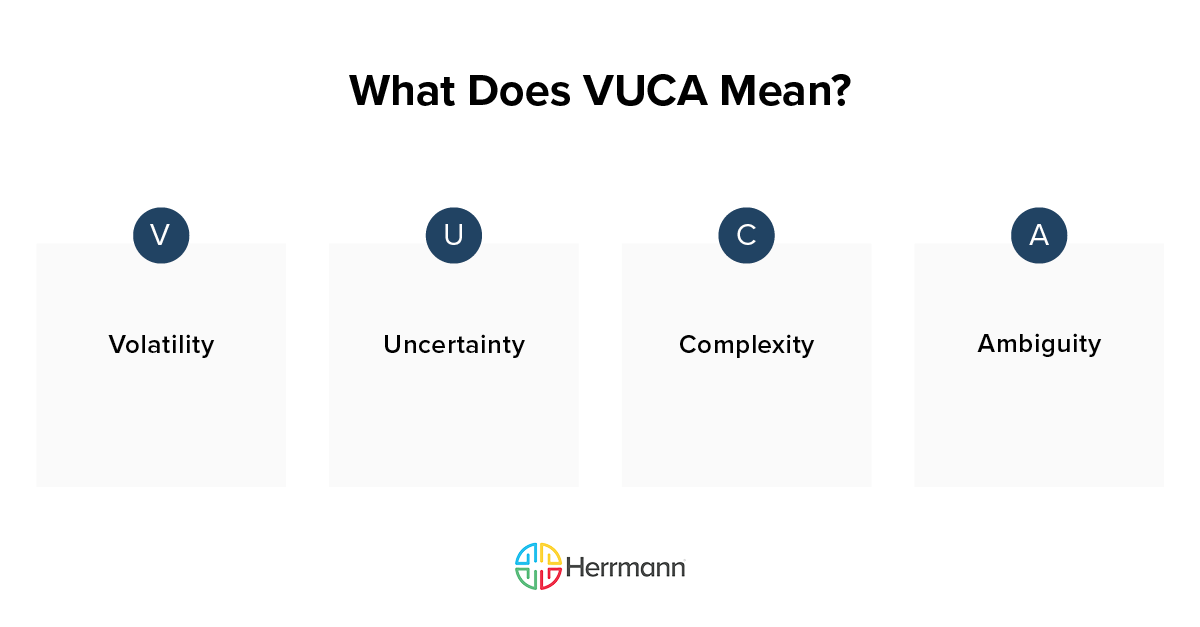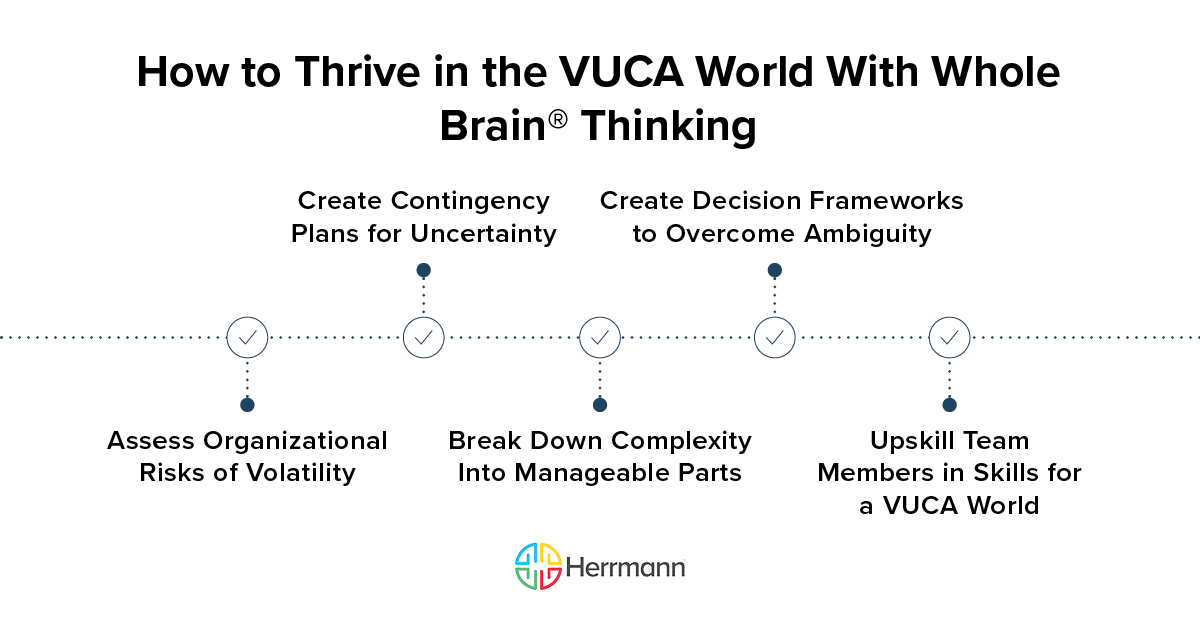Businesses operate in a very different world than they once did. Instead of stable conditions, predictable competition, and gradual technological advances, we must navigate a world of volatility, uncertainty, complexity, and ambiguity. There’s no avoiding this VUCA world, only adapting to it.
Acknowledging the stress and uncertainty of business conditions is one thing. But what separates organizations that thrive from those that wilt? Simply put, it’s resilience. To survive and thrive against VUCA forces, leaders must develop resilience in themselves, their teams, and their organizational structures.
Learn more about VUCA, how to thrive in a VUCA world, and how Whole Brain® Thinking can help teams build resilience, navigate change, and succeed despite uncertainty.
What Does VUCA Mean?
VUCA stands for volatility, uncertainty, complexity, and ambiguity. It describes how our rapidly changing world is unpredictable regarding the future state and the nature and pace of those changes. Warren Bennis and Burt Nanus were the first to use the term in the 1980s.
In the early 1990s, VUCA entered the popular consciousness when the U.S. Army War College used the acronym to shape its response to the post-Cold War era. In business, VUCA describes the challenges of operating in an ever-changing environment. Here’s more on what each letter in the acronym means.
Volatility
Volatility refers to an environment undergoing change and disruption. In a volatile environment, change is unpredictable and often occurs suddenly. Change is hard to anticipate, and so are the extent and timespan. This complicates your organization’s ability to keep up with trends and anticipate future needs.
One example of volatility was the COVID-19 pandemic. Within a short period of time, many organizations had to switch from fully in-person to fully remote while maintaining operations — and without knowing when the situation would ease or what further changes awaited.
Uncertainty
Uncertainty refers to the lack of predictability during times of change. Planning becomes more difficult because today’s conditions aren’t fully understood, much less the future’s. Failure to deal with uncertainty can create organizational paralysis as decision-makers second-guess themselves.
One example of uncertainty is when a competitor disrupts the marketplace with a new product or offer. The incumbent company might struggle to understand whether the new entrant is a real threat in the near or long term. Without that, the incumbent might not know how to respond, or it might drag its feet to avoid making a decision.
Complexity
Complexity refers to the many dependent factors involved, each of which could be in a different stage of change or importance. When companies don’t understand the complex environments they’re operating in, they’re challenged to craft a coherent and focused response.
One example is inflation, which can have multiple complex causes that differ based on your industry or products. Responding to inflation is more difficult when assessing a mass of interconnected factors that may or may not affect your business.
Ambiguity
Ambiguity refers to a lack of clarity about what’s going on. Ambiguity means you’re challenged to understand what’s factual and most important, much less what you should do next.
Sign up to our newsletter for the latest insights

Why Is It Important to Understand VUCA?
Understanding the principles of VUCA helps companies realize what they know and can control and, more importantly, what they can’t. When your teams understand a VUCA environment, they can focus on crafting strong responses rather than getting caught up in confusion and uncertainty.
Employers can also use the VUCA framework for scenario planning — identifying areas of concern or improvement, then brainstorming ways to prevent, mitigate, or adapt to those scenarios.
Thriving In a VUCA World With Whole Brain® Thinking
Businesses must be resilient and agile to thrive in a VUCA world. Resilient and agile organizations adapt to change and maintain strong performance even when nothing seems certain. While these traits can be learned, they aren’t automatically granted. As your organization looks to increase its resistance and adaptability, consider the power of strengthening your workforce’s cognitive diversity.
Cognitive diversity is based on the idea that every person, regardless of background, experience, or thought processes, contributes unique and worthy insights. One of the best ways to build cognitive diversity within your team is to implement the Whole Brain® Thinking framework, including having employees take the Herrmann Brain Dominance Instrument (HBDI®) assessment.
The HBDI® Assessment helps leaders and individuals identify and understand their preferred thinking processes within the Whole Brain® Thinking framework. The framework contains four quadrants: Analytical (Blue), Structural (Green), Relational (Red), and Experimental (Yellow).
Individuals, teams, and organizations are meant to use all four quadrants of the brain in their thinking processes, regardless of their mix of preferred thinking preferences. While we all have preferences, there’s no “good” or “bad” way of thinking, and no ideal mix of quadrants.
Here are some ways the Whole Brain® Thinking framework applies to VUCA examples.
Assess Organizational Risks of Volatility
To build resilience against volatility, have your team create risk management plans to navigate unexpected and changing circumstances. As you conduct this corporate management exercise, think of Whole Brain® in terms of four questions:
- What is causing volatility? (Blue)
- How can it be solved? (Green)
- Who will be affected? (Red)
- Why are we addressing this? (Yellow)
For example, supply chain disruptions affected many manufacturers in 2021. They struggled to obtain raw materials, parts, and other crucial resources to make their products.
If a manufacturing team was looking to build resilience against such volatility, the different thinking preferences of your employees could add valuable perspectives. Blue thinkers might emphasize the complex numbers and facts, such as the amount of stock on hand and the extra costs of seeking alternative suppliers. You’d want your Green thinkers to help map a coherent plan that assigns clear responsibilities to each person and department.
The Red quadrant of Whole Brain® Thinking is a powerful contributor because you must consider how this volatility affects your suppliers, customers, and employees. And people whose thinking preferences trend to Yellow can unlock new solutions to new problems, especially when it’s clear that the status quo no longer applies.
As a reminder, everyone can and does use all four quadrants daily. And many people have strong preferences for multiple quadrants, which can add further perspective and insight.
Create Contingency Plans for Uncertainty
One of the challenges of uncertainty is that people become afraid to act. After all, clear solutions aren’t available, and every option carries at least some level of risk. Building resilience against uncertainty is easier when teams have mission-driven values, playbooks, and processes to fall back on
Contingency plans help teams react with a purpose to unforeseen events. Whole Brain® Thinking helps people understand their strengths, weaknesses, preferences, and avoidances — and each other. With that knowledge, your business might be facing great uncertainty, but there's one thing you know for sure — that your team trusts each other to collaborate on possible solutions.
Break Down Complexity Into Manageable Parts
Complexity isn’t just about changing your mindset. Tackling a more significant interwoven problem is often impractical and can be demoralizing. The key is to break down complex problems into smaller, achievable tasks.
Here’s how your team might tackle a complex problem and where Whole Brain® Thinking can help. First, you identify the core components, analyze them, and break them into smaller, more manageable parts. This analytical approach is quintessential Blue thinking while also bringing in the Green traits of planning and organization. By taking a fresh approach to a once-intractable problem, you’re taking a big-picture, creative view (Yellow).
Second, with these smaller components in hand, form a plan for each component, including setting a timeline and assigning tasks to individuals or teams. This is Green thinking in action, along with bits of Blue (analyzing the proper timeline) and Red (considering which tasks best suit each person’s skills).
Third, as this plan unfolds, you’ll want a communication, collaboration, and monitoring system.This ensures that the plan stays organized (Green), progress is measured (Blue), and people know what’s going on (Red). As people work on various components and report in, you might discover synergies you otherwise would have missed (Yellow).
Every quadrant of thinking is essential to success when your team deals with the VUCA state of complexity.
Create Decision Frameworks to Overcome Ambiguity
Your team can build resilience against ambiguity by creating frameworks, processes, or structures that help people make decisions in the face of unknowns. Using the Whole Brain® Thinking model, you can outline your decisions by asking questions like:
- What does the data say about our current state? How will we measure success? (Blue)
- What’s the plan of action? What processes and guidelines should we use? (Green)
- Does everyone have a clear role? Who’s affected by this plan? (Red)
- Why are we doing this? Have we explored all feasible options? (Yellow)
Ambiguity isn’t ideal, but it can create more freedom to explore and experiment because the known answers of yesterday no longer apply. Ensure that experimentation is followed by measurement, analysis, and reflection.
Upskill Team Members for a VUCA World
Operating in a VUCA environment requires different skills, just as new industries and emerging technologies also push workers to develop new abilities. For example, if your organization is adding artificial intelligence (AI) and machine learning to its processes, that can cause significant volatility and uncertainty for workers worried about their futures. Ambiguity results if leadership isn’t clear and forthright about what these technologies mean.
Leaders using Whole Brain® Thinking will connect technology’s ability to augment the existing workforce’s capabilities, including their cognitive diversity. They’ll explain this technology, how it'll impact the organization’s business, whose job duties will be affected (and how), and why the transformation is essential to the organization’s survival.

Thinking Agility in a VUCA World
In a VUCA world, the world changes quickly, and leaders with the capacity for deep thinking and agility will gain an advantage.
In this video, Herrmann Chair Chief Thought Leader Ann-Herrmann Nehdi shares four steps to help leaders and their teams navigate the VUCA world and develop their thinking agility to quickly adapt to unexpected changes.
“You don't have to be a CEO to redefine leadership,” she says. “You just need to understand how you can better flex your thinking. Look at the competencies that are most challenging for you today and start working on developing those before you get caught off guard.”
Build Your Team’s Capacity for the VUCA World
Building resilience and agility isn't easy, but everyone is capable of personal growth. When your employees trust and embrace each other’s cognitive diversity, they’re primed to think differently and more effectively, even during the most challenging situations.
How your organization experiences the VUCA world will be unique, but all of us will have to get comfortable with volatile, uncertain, complex, and ambiguous situations. Help your teams embrace this new reality collectively and collaboratively.
Learn how organizations are managing the threat of business disruption with Whole Brain® Thinking.


.jpg?width=1200&name=VUCA_World-Featured%20(2).jpg)









